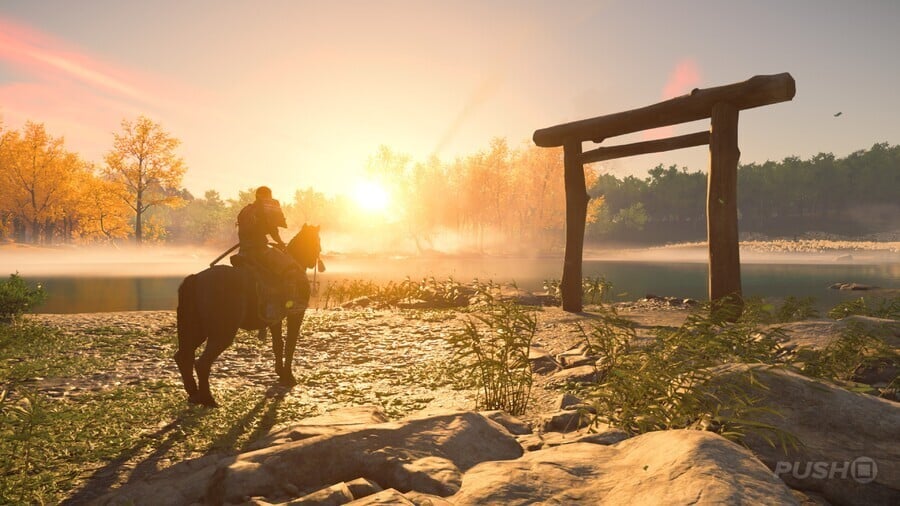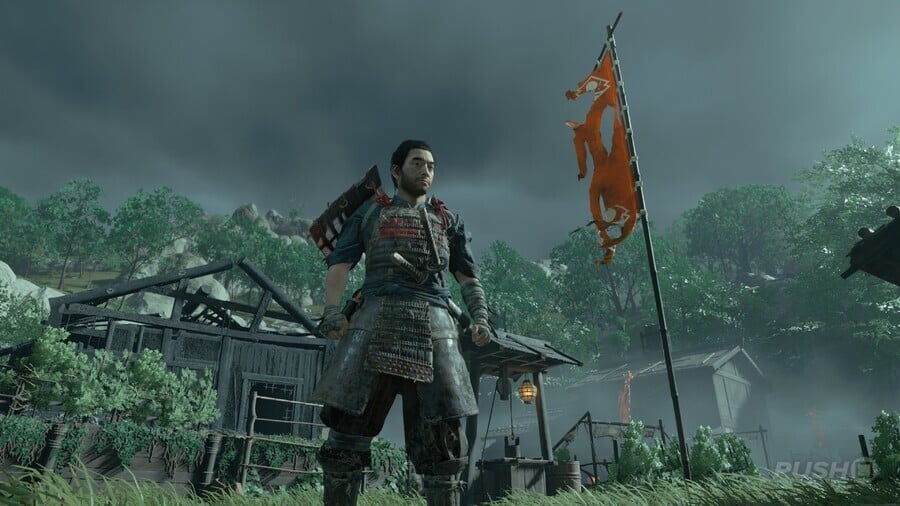
Ghost of Tsushima is an open world action game from Sony first party developer Sucker Punch. It's a new property that's set on the Japanese island of Tsushima in 1274, as the Mongol Empire invades. We gave the title an 'Excellent' score of 9/10 in our Ghost of Tsushima PS4 review, describing it as "one of the greatest open world games of the generation".
And things have gotten even better with the release of Ghost of Tsushima: Director's Cut, on both PS5 and PS4. Director's Cut launched on the 20th August, 2021, just over a year after the original game's release, and as of 16th May, 2024, can be purchased on PC. It includes PS5 and PC-exclusive features, as well as an all-new expansion that takes place on Iki Island. You can read more about the expansion in our Ghost of Tsushima: Director's Cut PS5 review.
In this Ghost of Tsushima guide, we're going to share our beginner's tips and tricks that'll help you get to grips with this epic samurai adventure. We'll also be linking to all of our Ghost of Tsushima location guides, which tell you where to find Hot Springs, Bamboo Strikes, Fox Dens, Haikus, Shinto Shrines, and Pillars of Honor.
We've even got guides on the game's best armor, the best Charms, and the best Techniques to learn. Meanwhile, our difficulty settings guide is great for new players, as is our accessibility options guide.
Ghost of Tsushima Guide: All Locations
Ghost of Tsushima has an abundance of hidden locations for you to find all over its open world. We've listed all of the location types that you'll want to find below.
- Hot Springs are locations where main character Jin can take a bath and increase his maximum health.
- Bamboo Strikes are locations where Jin can hone his sword skills. Complete a button input minigame and you'll increase Jin's maximum Resolve — a resource that's needed to heal both in and out of combat. Resolve is also used to unleash special attacks.
- Fox Dens are locations where you'll find a friendly fox. Follow the fox and it'll lead you to an Inari Shrine. Find enough Inari Shrines, and you'll unlock new Charm slots, letting you customise Jin's abilities further.
- Haikus are locations where Jin can sit down and reflect upon different topics. You get to compose your own haiku — a kind of Japanese poem — about the topic at hand. Once you're done, you're gifted a unique cosmetic headband.
- Shinto Shrines are locations where Jin will be tasked with climbing to an ancient prayer site. These locations involve platforming challenges, as Jin jumps, swings, and clambers his way to a picturesque peak. Completing these shrines grants you some powerful rare Charms.
- Pillars of Honor are monuments where you'll find cosmetic Sword Kits.
- Lighthouses provide a boost to your Legend Rank when they're rekindled.
- Animal Sanctuaries are locations exclusive to Iki Island, the expansion included in Ghost of Tsushima: Director's Cut. Finding them nets you some powerful Charms.
- Memories of Your Father are playable glimpses of Jin's past, which can be found at set locations around Iki Island, the Ghost of Tsushima: Director's Cut expansion.
- Archery Challenges are activities where Jin can put his archery skills to the test. They're exclusive to Iki Island.
- Iki Island Wind Shrines are mysterious stone shrines where Jin must solve a riddle.
We've listed all the key points of interest below:
- All Hot Spring Locations
- All Bamboo Strike Locations
- All Fox Den and Inari Shrine Locations
- All Haiku Locations
- All Shinto Shrine Locations
- All Pillar of Honor Locations
- All Lighthouse Locations
- All Hidden Altars Locations
- All Iki Island Animal Sanctuary Locations
- All Iki Island Memories of Your Father Locations
- All Iki Island Archery Challenge Locations
- How to Solve Blood-Stained Shrine, Shrine of Ash, and Shrine in Shadow on Iki Island
Ghost of Tsushima Guide: Armor and Progression
In this next part of our Ghost of Tsushima guide, we're going to be covering character progression.
There are three main topics to consider:
- Armor can be found across Tsushima, and different armor grants Jin different perks. Some armor is great for boosting your abilities in combat, with other armor enhances exploration.
- Charms are accessories that can be found throughout the game. Some are more common than others, but all of them bolster Jin's abilities in some way.
- Techniques are abilities and perks that Jin can unlock with Technique Points.
Making good use of armor, Charms, and Techniques can transform Jin into a near unstoppable force. With that in mind, we've created the following guides to help you get the most out of Jin's abilities:
- Best Armor and How to Get All Armor Sets
- Best Charms and Where to Find Them
- All Techniques and Best Techniques to Learn
Ghost of Tsushima Guide: Trophies and FAQs
In this part of our Ghost of Tsushima guide, we'll go over Trophies, various hints, and some of the frequently asked questions that you may have about the game.
Trophies
- All Trophies and How to Get the Platinum
- How to Dress Up as a Legendary Thief
- How to Find Black and White Dye Merchants
- How to Find A Friend's Grave Location
- All Mythic Tales and Rewards
- How to Get the Monkey See Trophy on Iki Island
Resources
FAQs
- How Long Does It Take to Beat?
- How Many Acts Are There?
- How Many Side Quests Are There?
- Can Quests Be Missed?
- Does It Have New Game +?
- How to Start New Game + and What Carries Over
- What Difficulty Should You Select?
- All Accessibility Options
- How to Put Your Sword Away
- How to Play Your Flute
- How to Bow
- Does It Have Online Multiplayer?
- How to Play Ghost of Tsushima Legends Co-Op

Ghost of Tsushima Guide: Tips and Tricks for Beginners
Ghost of Tsushima can be a bit of a tricky game to begin with as you get to grips with Jin's abilities and the attack patters of his enemies. As such, we've put together a number of tips and tricks that will hopefully help you survive the Mongol invasion.
Patience Is a Virtue
Jin is a samurai at heart, and to maximise his effectiveness in battle, you should avoid swinging your sword around like a madman. Combat in Ghost of Tsushima is very reactionary. Jin's defence is just as important as his offence, and correct use of parries, perfect parries, and dodges is paramount. Deflecting or avoiding incoming attacks is usually the best way to get in and deal some damage.
To begin with, you should always prioritise defending over attacking, especially since Jin's health bar starts off so small. Watch your enemies and learn their movements, before capitalising on their mistakes. Be calm and patient, just like a samurai, and you'll find victory.
Stances are the Key to Efficient Victory
Jin will eventually unlock four different combat stances as you progress through the game. Each stance is especially effective against a specific type of enemy, and you can switch between stances at any time by holding down R2 and pressing the corresponding face button.
While any enemy can be defeated using any stance, switching to the right stance at the right time can turn a five minute battle into a skirmish that lasts just 30 seconds. Making the most of each stance transforms Jin into a foe to be feared. Using the correct stance allows Jin to break through an enemy's guard with ease.
For example, the Water Stance is incredibly effective against enemies with shields. Usually, these more defensive foes will shrug off Jin's attacks and you'll have to open them up with deft movement or parries. But with the heavy combos of the Water Stance, you can smash through their defensive posture in just a few hits, leaving them staggered and helpless.
Ghost Weapons Can Turn the Tide of Any Battle
Ghost Weapons are steadily unlocked as you progress through the game. Mapped to R1, weapons such as kunai (throwing knives), bombs, and sticky explosives give Jin a noticeable advantage in combat when they're used correctly. Kunai can break the guard of multiple enemies at once, while explosives can decimate tightly packed groups.
Ghost Weapons are limited — when you run out you'll have to scavenge more from dead bodies or from around the surrounding area — but you shouldn't be stingy with them. If you're being overwhelmed by sheer numbers and you find yourself being pushed to breaking point in a fight, don't give up. Make use of your Ghost Weapons to get out of a tight spot — think of them like the ace up Jin's sleeve. A well timed kunai or smoke bomb can chance the course of combat in an instant.
Enemy Combos Need to Be Respected
In many modern action games, enemies will often throw out a single attack and then it's your turn to retaliate. This is the not the case in Ghost of Tsushima. The Mongols have their own combos, and immediately trying to strike back after blocking the first attack will usually result in you eating the rest of their moves.
This ties back to our first tip about being patient. Don't lower your guard until you're absolutely sure that your opponent has finished swinging, and remember to watch out for unblockable attacks, highlighted by red or blue glints that appear on the enemy's weapon. These unblockable moves can sometimes be a part of a foe's combo, so you'll have to mix blocking with dodging to survive.
And that's all for our Ghost of Tsushima guide. We hope that it's helped you in some way, and we hope that you're enjoying the game as much as we did. If you've got your own tips and tricks to share, feel free to post them in the comments section below.





Comments 7
Nice screen shot to start out the topic. I'm about to start the game. Thanks for the tips.
Thanks son for this
Stances are the Key to Efficient Victory!
@psgamer2 Yes!
This guide has been fully updated for the PC release.
Strangely I played this a bit when I first got my PS5 but didn't stick with it, the controls felt a little off for me. Maybe I'll pick it back up and have another go, did look fantastic though.
@psgamer2
100% As soon as I figured out stances the game went easy mode and I had to up the difficulty setting.
Show Comments
Leave A Comment
Hold on there, you need to login to post a comment...